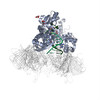+Search query
-Structure paper
| Title | Molecular architecture of the Ub-PCNA/Pol η complex bound to DNA. |
|---|---|
| Journal, issue, pages | Sci Rep, Vol. 5, Page 15759, Year 2015 |
| Publish date | Oct 27, 2015 |
 Authors Authors | Wilson C Y Lau / Yinyin Li / Qinfen Zhang / Michael S Y Huen /  |
| PubMed Abstract | Translesion synthesis (TLS) is the mechanism by which DNA polymerases replicate through unrepaired DNA lesions. TLS is activated by monoubiquitination of the homotrimeric proliferating cell nuclear ...Translesion synthesis (TLS) is the mechanism by which DNA polymerases replicate through unrepaired DNA lesions. TLS is activated by monoubiquitination of the homotrimeric proliferating cell nuclear antigen (PCNA) at lysine-164, followed by the switch from replicative to specialized polymerases at DNA damage sites. Pol η belongs to the Y-Family of specialized polymerases that can efficiently bypass UV-induced lesions. Like other members of the Y-Family polymerases, its recruitment to the damaged sites is mediated by the interaction with monoubiquitinated PCNA (Ub-PCNA) via its ubiquitin-binding domain and non-canonical PCNA-interacting motif in the C-terminal region. The structural determinants underlying the direct recognition of Ub-PCNA by Pol η, or Y-Family polymerases in general, remain largely unknown. Here we report a structure of the Ub-PCNA/Pol η complex bound to DNA determined by single-particle electron microscopy (EM). The overall obtained structure resembles that of the editing PCNA/PolB complex. Analysis of the map revealed the conformation of ubiquitin that binds the C-terminal domain of Pol η. Our present study suggests that the Ub-PCNA/Pol η interaction requires the formation of a structured binding interface, which is dictated by the inherent flexibility of Ub-PCNA. |
 External links External links |  Sci Rep / Sci Rep /  PubMed:26503230 / PubMed:26503230 /  PubMed Central PubMed Central |
| Methods | EM (single particle) |
| Resolution | 22.0 Å |
| Structure data | |
| Chemicals |  ChemComp-HOH:  ChemComp-DZ4:  ChemComp-MG:  ChemComp-GOL: |
| Source |
|
 Keywords Keywords | DNA BINDING PROTEIN / DNA / REPLICATION / PROCESSIVITY / ONCOGENE / DNA-BINDING SYSTEMIC LUPUS ERYTHEMATOSUS / TRANSFERASE/DNA / POL ETA / POLYMERASE / THYMINE DIMER / CPD / XPV / XERODERMA PIGM VARIANT / DNA DAMAGE / TRANSFERASE-DNA COMPLEX |
 Movie
Movie Controller
Controller Structure viewers
Structure viewers About Yorodumi Papers
About Yorodumi Papers






 homo sapiens (human)
homo sapiens (human)